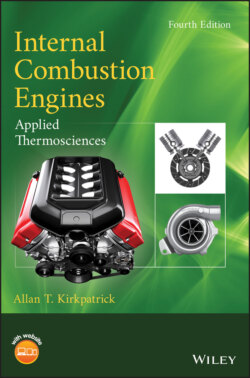Читать книгу Internal Combustion Engines - Allan T. Kirkpatrick - Страница 37
Stationary Gas Engine
ОглавлениеA stationary natural gas engine is shown in Figures 1.23 and 1.24. Typical applications for stationary engines include co‐generation, powering gas compressors, and power generation. The engine shown in Figure 1.23 is an in‐line eight‐cylinder turbocharged engine, with rated power of 1200 kW, bore of 240 mm, and stroke of 260 mm for a total displacement of 94 L. The compression ratio is 10.9:1. This type of engine is designed to operate at a constant speed condition, typically 1200 rpm. Each cylinder has two intake and two exhaust valves. The piston has a combustion bowl with a deep dish concentrated near the center of the piston, so most of the clearance volume is in the piston bowl.
Since natural gas engines are operated lean to reduce nitrogen oxides (), prechambers are used to initiate a stable combustion process. Pressurized natural gas is injected into a prechamber above the piston, and a spark plug in the prechamber is used to ignite the natural gas. The increase in pressure projects the burning mixture into the main combustion chamber, where the final stages of the combustion take place. Prechambers are also used in high‐speed diesel engines to achieve acceptable mixing and more complete combustion.
Figure 1.23 A 94 L L8 stationary natural gas engine. (Courtesy of Cooper Energy Services, Inc.)
Figure 1.24 Cutaway view of 94 L L8 stationary natural gas engine. (Courtesy of Cooper Energy Services, Inc.)
